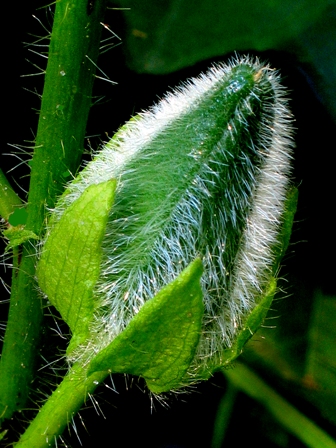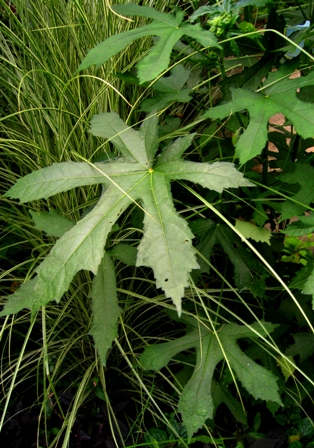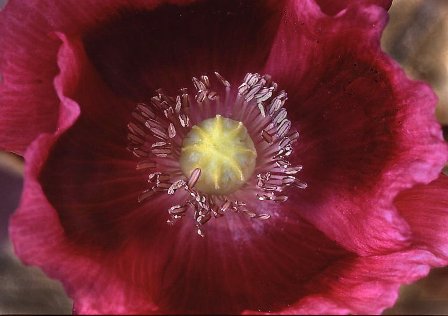Nancy’s post about fun annuals got me thinking about a few of my own must-haves. I experiment with loads of annuals, tender perennials and tropicals every season, and am in deep zonal denial. I’m always on the lookout for bold or colorful (or, better still, bold and colorful) foliage, bright floral colors, and plants that really pay the rent.
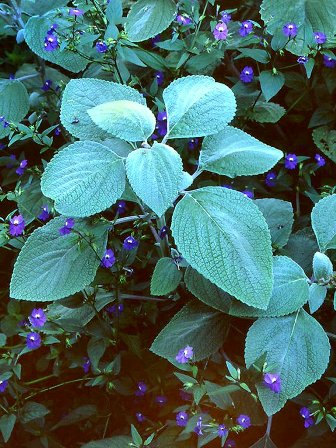 I can never understand why I don’t see Bush Violet (Browallia americana). Sure you can buy some of its hybridized, blowsy-bloomed offspring at almost any garden center, but I’m talking about the straight species, the forebear of all those other ones. This easy annual grows in sun, shade, wet, or dry, in lean or rich soil. Given an early start – I usually sow seeds indoors in February – it will bloom from early July right through a mild frost or two. The plant’s twining stems grow to about 2 feet tall high and wide. They twist and weave through their neighbors, neatly lacing almost any composition together with a cloud of starry little magenta-kissed blue flowers with white centers. They’re more than capable of carrying a whole tableau right through summer – they’re an essential ingredient in knitting together Fergus Garrett’s 100-yard-long mixed border at White Flower Farm, and my garden as well.
I can never understand why I don’t see Bush Violet (Browallia americana). Sure you can buy some of its hybridized, blowsy-bloomed offspring at almost any garden center, but I’m talking about the straight species, the forebear of all those other ones. This easy annual grows in sun, shade, wet, or dry, in lean or rich soil. Given an early start – I usually sow seeds indoors in February – it will bloom from early July right through a mild frost or two. The plant’s twining stems grow to about 2 feet tall high and wide. They twist and weave through their neighbors, neatly lacing almost any composition together with a cloud of starry little magenta-kissed blue flowers with white centers. They’re more than capable of carrying a whole tableau right through summer – they’re an essential ingredient in knitting together Fergus Garrett’s 100-yard-long mixed border at White Flower Farm, and my garden as well.
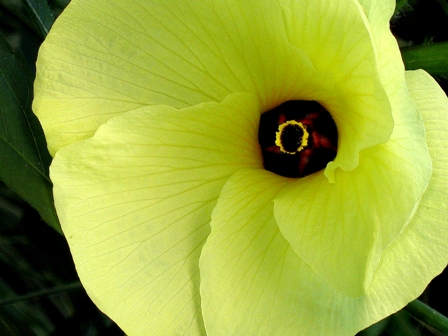 Another stunner, one of grander stature, is Sunset Hibiscus (Abelmoschus manihot). This fast-growing okra relative loves heat and sun and will quickly reward you with a five or more foot tall plant rich with hand-shaped leaves more than a foot across, and big, dark-eyed primrose-yellow flowers, which, coming as they do in late summer, provide a color rarely seen at that time of year. And once the flowers have gone by, they yield the cutest little fuzz-covered seed pods.
Another stunner, one of grander stature, is Sunset Hibiscus (Abelmoschus manihot). This fast-growing okra relative loves heat and sun and will quickly reward you with a five or more foot tall plant rich with hand-shaped leaves more than a foot across, and big, dark-eyed primrose-yellow flowers, which, coming as they do in late summer, provide a color rarely seen at that time of year. And once the flowers have gone by, they yield the cutest little fuzz-covered seed pods.
A third fun annual that finds more and more spots in my yard every year is Lauren’s Grape Breadseed Poppy (Papaver somniferum ‘Lauren’s Grape). Though this a fairly ephemeral plant – it comes and goes all too fast – I cherish its short-lived splendor. The Japanese have special word for the almost aching appreciation of passing fragile beauty, and I do too: ‘Lauren’s Grape’.
It originated in Lauren Springer’s Colorado garden. Lauren told me she spent years growing every kind of poppy she could find, even going so far as to scrape the seeds off bagels just to see what might pop up. After many poppy-filled years, a stunner popped up. It was an eye-catching Kool-Aid-colored magenta single flower and to Lauren it represented the apex of poppydom. She promptly plucked out every other poppy to let this one produce seeds undiluted by the DNA of other poppy pollen. Then for six years she yanked every poppy that did not display that true color and exquisite single form. By then she had a reliable seed strain that would come true, which is bot-speak meaning to produce plants identical to their parent.
I was lucky enough to get a bag of seeds from Lauren years ago and have been appreciating the, er, fruits of her labors ever since. Thanks Lauren! When it comes to seed-grown plants it doesn’t get any easier than these: Get a handful of seeds, then just throw ‘em and grow ‘em. Sprinkle the seeds in February or so. The resulting plants will self-sow in subsequent years.
You can get all these seeds from Select Seeds. The first two are also available from J.L. Hudson, a quirky little idiosyncratic catalog that is among my very favorites.

